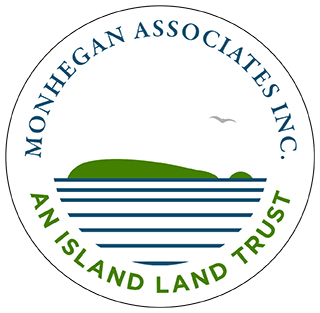Make a donation of your choice below. If the donation is in honor of someone or for a specific purpose, you will have the opportunity to indicate that when you get to the Paypal/credit card payment page.
[wp_eStore_fancy2 id=10]
If you prefer you may pay by check (made out to Monhegan Associates). Send to Clare Durst, Membership Chair, 8 Muskie Place Topsham ME 04086 and indicate if the donation is in honor of someone or for a specific purpose.
Why do we need donations?
For Trail rehabilitation
In 2005 Lester Kenway of the Maine Conservation Corps made an assessment of the condition of the trails on Monhegan Associates’ land. His report included an exhaustive list of trail improvement recommendations that can be viewed here. In recent years we have begun to implement these improvements as we have been able. In the fall of 2013 Lester Kenway returned to Monhegan to train a crew of island workers to carry out the work. He will return in the fall of 2014 to provide further training.
This work is extremely important for a variety of reasons. Well designed trails prevent environmental degradation by providing adequate water drainage, erosion prevention measures, and other safeguards against human impact. At the same time, well-made trails are safer for hikers who benefit from secure footing.
Funds dedicated to trail rehabilitation efforts will go towards:
- hiring an expert from off island to assess trails, train islanders in trail rehabilitation techniques, and oversee individual project planning.
- wages for island workers who carry out trail rehabilitation (including improvements such as bog bridges, water bars, stone steps, and other important features of well designed trails).
- materials needed trail trail rehabilitation including specialized tools and wood for new infrastructure such as bog bridges.
Invasive species management
In the 1990s it came to our attention that invasive plant species were becoming a problem on Monhegan. While many parts of New England are contending with a wide range of invasive plants and animals, Monhegan has been particularly vulnerable to invasion due to to the presence of deer on the island. Between 1955 when deer were first introduced, and 1998 when the herd was removed from the island, the grazers ate much of the native growth on the island, preventing the forest from regenerating. One of the first invasive plants to spread through the wildlands was Japanese barberry, a prolific, thorny plant that is inedible to deer. With time, however, we have seen a wide range of other invasive plants come in. These include black swallow-wort, asiatic bittersweet, multi-flora rose, japanese knotweed, purple loosestrife, himalayan balsam and others.
Since the removal of the deer 16 years ago, the forest has begun to regenerate. At the same time, the invasives have continued to spread. Our efforts are focused on areas where we can remove invasives and allow native species to repopulate. We can’t remove every invasive plant on the island, but we can do our best to give the native species the upper hand.
Funds dedicated to invasive species management will go towards:
- mapping of invasive species on Monhegan Associates land.
- hiring an expert from off island to assess the problem and determine primary areas of focus.
- wages for invasives removal carried out by island workers.
- research into techniques for invasive plant control.
![]()
